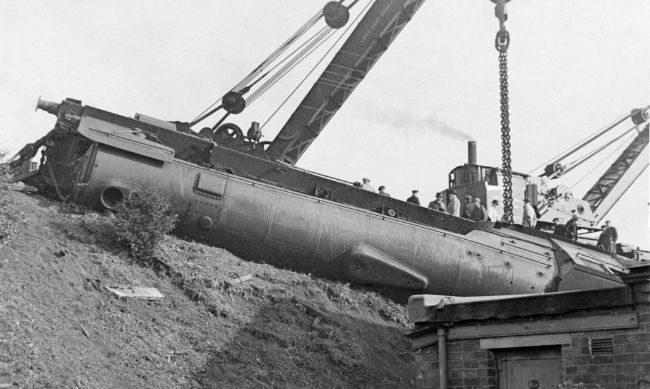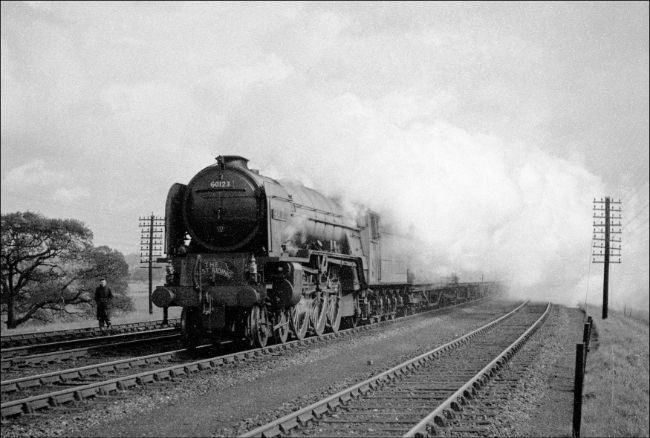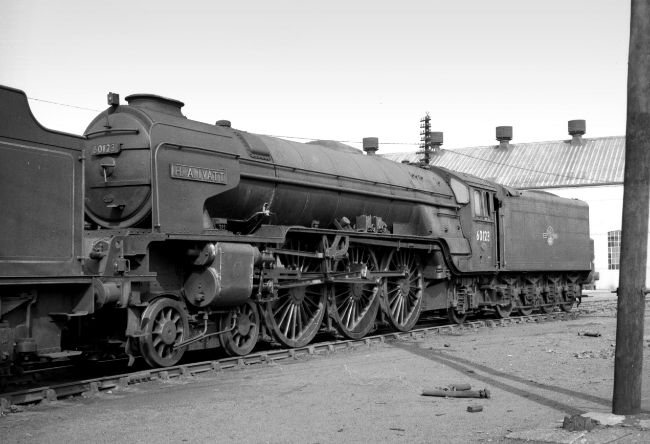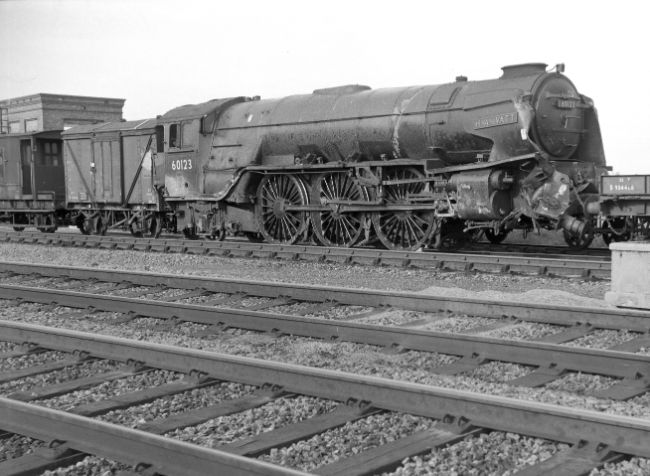The last of the initial A1 order, Engine Order No. 382, No. 60123 was the tenth member of the class to be built at Doncaster. Its works number was 2040. With Darlington-built No. 60142 also entering service on 10th February 1949, they were the 22nd and 23rd A1s to come into traffic. Of note is that No. 60123 was the first A1 to be shedded at Doncaster. Livery of this plain-chimneyed Pacific was the customary apple green with black and white lining and the nationalised railway’s name carried on the tender in white block capitals. The first working recorded was a down passenger train into Newcastle then a visit to Gateshead shed, both on 16th June. No. 60123 was probably one of the first Peppercorn A1s to be involved in a serious accident; whilst working a fast goods train on the Lincoln avoiding line the locomotive ran into the back of a slow moving goods train near Coulsdon Road and was derailed, ending up on its side on the embankment. The date was the 25th October and since the accident only involved goods, rather than passenger trains, no official record seems to have been made. No-one was seriously injured, although the guard of the slow goods was treated in hospital having survived the demolition of his van and its subsequent destruction by fire! After only ten months in its original livery, No. 60123 was delivered to Doncaster on November 7th for what was recorded as a ‘light casual repair’ (!) followed by repainting into BR express blue before its release in December. This was the fifth of the 39 A1s delivered new in green to be repainted. A transfer to Grantham shed on 19th March 1950 kept its area of operations on the English section of the East Coast Main Line; No. 60123 was seen at Newcastle on March 25th and at Darlington on 23rd April.

No. 60123 lies on its side at Lincoln on 25th October 1952 - Stephen Williams
A transfer to Copley Hill shed on 4th June shifted No. 60123’s operations to Yorkshire and the lower section of the main line. In fact, it was to remain a Yorkshire-based engine for the rest of its life. Naming in July as H. A. Ivatt commemorated an eminent Great Northern Railway CME, one of three from that railway carried by A1s and one of half a dozen class members named after East Coast engineers. This locomotive was among the earlier A1s to be named with another six so treated that month while another nine had been named earlier. A special train was the return ‘Ivatt Atlantic’ special to King’s Cross which on its outward trip was hauled by the last Ivatt 4-4-2 on its final run, No. 62822, on 26th November; unfortunately, an extra fast schedule was spoiled by an over-heated axlebox on a restaurant kitchen car, causing a considerably delayed arrival with No. 60123 at the terminus. Other changes were the fitting of a lipped chimney and the removal of the Flaman speed recorder.
Yet another reallocation came on 9th September 1951 with a move to Ardesley shed. H. A. Ivatt’s first named trains were the down ‘Queen of Scots’ on 25th May 1952 from Leeds-King’s Cross and the up train as far as Leeds on 26th July. Between October and December, No. 60123, along with Nos. 60122 and 60135, was experimentally fitted with an inside connecting rod with a Swindon-style forked big end with a clip and cotter arrangement to secure the brasses. At the conclusion of this trial in 1956 it was deemed to have been a success. H. A. Ivatt was one of the last A1s to be repainted into BR green; it was one of three done in December 1952 after 43 had already been dealt with. The start of the next year found No. 60123 as one of ten class members hurriedly fitted with the Hudd system of ATC. Of note are two specials, a Rugby special into King’s Cross on 25th April and a Cup Final special to the same destination on 2nd May. A less common working was the 06.05hrs King’s Cross-Cambridge on 15th July 1954. In the mid-1950s the smokebox numberplate and handrail were transposed. Detailed logs at King’s Cross between September 1956 and January 1957 show No. 60123 primarily on trains to Leeds with the 09:18hrs, 13:18hrs and 15:40hrs departures noted but by far the most common turn was the 18:15hrs. Several noon departures with the ‘Queen of Scots’ were noted plus the 07:50hrs King’s Cross-Newcastle/Bradford and the 08:20hrs to Edinburgh. On 17th November 1956 H. A. Ivatt was seen at Bradford shed under repair. Other named trains hauled included the down ‘West Riding’ on 6th and 22nd June 1953 and the down ‘Aberdonian’ from the capital on 26th September 1956. Observation on 1st June 1957 of a King’s Cross-Leeds train hauled via Lincoln was presumably due to diversions.

No. 60123 H.A.Ivatt on the down ‘West Riding’ at Potters Bar on 21st May 1955 – Robin Gibson
A transfer back to Copley Hill was made on 15th September 1957. The following January the later BR crest was applied to the tender. Trains to and from Yorkshire included the 08:21hrs up ‘West Riding’ on 27th June 1959 returning with the 16:48hrs to Leeds; the 11:15hrs up ‘Yorkshire Pullman’ on 8th August; then on 24th June and 1st July 1961 the 08:21hrs up ‘West Riding’ returning on the 16:20hrs down ‘Tees-Tyne Pullman’. A hockey special was hauled from Leeds to the ‘Cross on 10th March 1962. Around this time a Smith-Stone speedometer was fitted to one of the rear driving wheels.

An undated study taken at Doncaster – Bill Reed
Transfer back to Ardesley on 1st April 1962 presaged the last stage of No. 60123’s life. With six allocations it had been moved around more than most A1s. Passenger trains continued much as before, examples being the down ‘Tees-Tyne Pullman’ from the capital on 8th August and the 15:55hrs to Leeds on the 18th. The first recorded non-passenger working of No. 60123 also proved to be its last. On 7th September it suffered severe damage when it derailed at Offord when pulling the 08:20hrs King’s Cross Goods-Leeds. It entered Doncaster Works on the 24th but was withdrawn on 1st October, the first Peppercorn A1 to be condemned. With a service life of just 13 years 7 months, No. 60123 was one of the shortest-lived A1s. In its time it had carried seven boilers. Scrapping was at Doncaster Works; the last reported sighting of No. 60123 was in the Works yard on 14th October.

No. 60123 at Offord follwing the collision - Transport Treasury

H.A.Ivatt makes a sorry sight at Doncaster – Richard Greenwood
This history was compiled by Phil Champion based on a database compiled by Tommy Knox and with reference to the RCTS book “Locomotives of the LNER Part 2A” as background. Revised and updated by Graham Langer, April 2020.